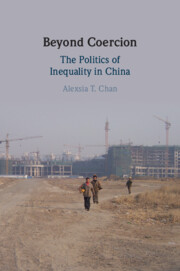Refine search
Actions for selected content:
42 results
Policy Experimentation within Bureaucratic Power Networks: The “Police–Business Cooperation” Scheme in Urban China
-
- Journal:
- The China Quarterly , First View
- Published online by Cambridge University Press:
- 29 August 2025, pp. 1-19
-
- Article
- Export citation
5 - Relieving Famines
- from Text 5 - On Relieving the People’s Suffering
-
-
- Book:
- Chinese Statecraft
- Published online:
- 17 July 2025
- Print publication:
- 31 July 2025, pp 80-92
-
- Chapter
- Export citation
1 - Inequality and the Autocrat’s Toolbox
-
- Book:
- Beyond Coercion
- Published online:
- 10 June 2025
- Print publication:
- 12 June 2025, pp 1-19
-
- Chapter
- Export citation
2 - A Theory of Political Atomization
-
- Book:
- Beyond Coercion
- Published online:
- 10 June 2025
- Print publication:
- 12 June 2025, pp 20-52
-
- Chapter
- Export citation
7 - Conclusion
- from Part II - Migrant Workers Blunting Control
-
- Book:
- Beyond Coercion
- Published online:
- 10 June 2025
- Print publication:
- 12 June 2025, pp 146-162
-
- Chapter
- Export citation
5 - Playing with Institutional Leeway
- from Part II - Migrant Workers Blunting Control
-
- Book:
- Beyond Coercion
- Published online:
- 10 June 2025
- Print publication:
- 12 June 2025, pp 101-121
-
- Chapter
- Export citation

Beyond Coercion
- The Politics of Inequality in China
-
- Published online:
- 10 June 2025
- Print publication:
- 12 June 2025
12 - The Papacy, Homosexuality, and Same-Sex Marriage
- from Part II - Women, Gender, Sexuality
-
-
- Book:
- The Cambridge History of the Papacy
- Published online:
- 28 February 2025
- Print publication:
- 20 March 2025, pp 349-373
-
- Chapter
- Export citation
Descriptive Social Norms as Underappreciated Sources of Social Control
-
- Journal:
- Psychometrika / Volume 72 / Issue 2 / June 2007
- Published online by Cambridge University Press:
- 01 January 2025, pp. 263-268
-
- Article
- Export citation
Returning to the Wild West: Jewish Violence, Social Reaction, Self-Help and Social Control
-
- Journal:
- International Annals of Criminology / Volume 62 / Issue 1 / March 2024
- Published online by Cambridge University Press:
- 19 April 2024, pp. 284-316
- Print publication:
- March 2024
-
- Article
-
- You have access
- Open access
- HTML
- Export citation
Landholding Inequality, Social Control, and Mass Opposition to Suffrage Extension
-
- Journal:
- British Journal of Political Science / Volume 54 / Issue 2 / April 2024
- Published online by Cambridge University Press:
- 25 August 2023, pp. 437-455
-
- Article
-
- You have access
- Open access
- HTML
- Export citation
La gouvernance plurinormative des manifestants : reconfigurations pénales, exceptionnalité et dégradation des droits pendant le G20 à Toronto
-
- Journal:
- Canadian Journal of Law & Society / La Revue Canadienne Droit et Société / Volume 37 / Issue 3 / December 2022
- Published online by Cambridge University Press:
- 16 January 2023, pp. 365-386
-
- Article
-
- You have access
- HTML
- Export citation
Greenwashing and public demand for government regulation
-
- Journal:
- Journal of Public Policy / Volume 43 / Issue 1 / March 2023
- Published online by Cambridge University Press:
- 12 December 2022, pp. 179-198
-
- Article
-
- You have access
- Open access
- HTML
- Export citation
Chapter 16: - The Neolithic
- from Part II - Science and History
-
- Book:
- The Evolution of Everything
- Published online:
- 03 November 2022
- Print publication:
- 24 November 2022, pp 223-238
-
- Chapter
- Export citation
8 - Relationships and Groups
-
- Book:
- Feeling, Thinking, and Talking
- Published online:
- 08 September 2022
- Print publication:
- 15 September 2022, pp 163-181
-
- Chapter
- Export citation
Is value portable? An examination of contextual and practical considerations that affect the transferability of value assessments between settings
-
- Journal:
- International Journal of Technology Assessment in Health Care / Volume 38 / Issue 1 / 2022
- Published online by Cambridge University Press:
- 21 April 2022, e39
-
- Article
- Export citation
Deleuze, Beckett, and the Art of Multiplicity
-
- Journal:
- New Theatre Quarterly / Volume 38 / Issue 2 / May 2022
- Published online by Cambridge University Press:
- 20 April 2022, pp. 186-194
- Print publication:
- May 2022
-
- Article
- Export citation
Introduction
-
- Book:
- Enemies of the People
- Published online:
- 08 October 2021
- Print publication:
- 21 October 2021, pp 1-26
-
- Chapter
- Export citation
10 - Involving the Party, 1943–1944
-
- Book:
- Enemies of the People
- Published online:
- 08 October 2021
- Print publication:
- 21 October 2021, pp 221-244
-
- Chapter
- Export citation
